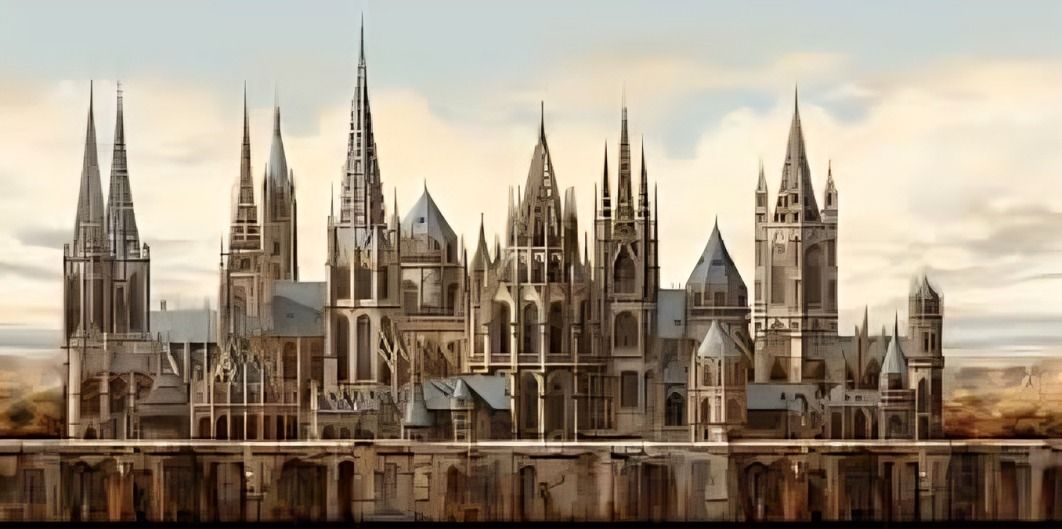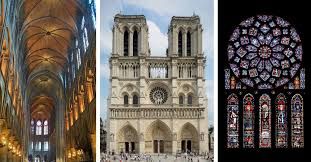
“
The development of Gothic architecture marked a revolutionary phase in European architectural history. Emerging in the 12th century, this style emphasized verticality, light-filled spaces, and intricate designs. Features such as pointed arches, ribbed vaults, and flying buttresses became iconic. This Development of Gothic Architecture Factsheet delves into its origins, influences, and enduring impact on cathedrals, churches, and civic structures. Uncover how Gothic architecture blended engineering innovation with artistic beauty, shaping iconic landmarks like Notre-Dame and Chartres Cathedral, leaving a timeless mark on the architectural world.1
1
”
Gothic architecture originated in France during the 12th century and flourished until the 16th century, characterized by pointed arches, ribbed vaults, and flying buttresses to support larger and taller structures. 1
Gothic cathedrals often took centuries to complete, like Notre Dame de Paris (1163–1345) and Cologne Cathedral, started in 1248, with its iconic spires finished over 600 years later. 2
The pointed arch, a hallmark of Gothic architecture, improved weight distribution compared to rounded arches, enabling the creation of taller, more slender, and structurally efficient buildings.3
Flying buttresses, originating in 3rd-century Europe, became central to Gothic cathedral design (12th-16th centuries), with early examples seen in the Basilica of San Vitale, Ravenna, Italy. 4

Stained glass windows, prominent in Gothic cathedrals, are larger than in other churches, flooding interiors with tinted light and often depicting biblical stories through intricate decorative scenes.
Gothic architecture was primarily used for cathedrals, churches, and monasteries, as the style was heavily influenced by religious themes, with soaring ceilings designed to evoke the majesty of God. 5
Ribbed vaults enabled architects to design intricate structures by using intersecting ribs as a skeletal framework, efficiently distributing roof weight and allowing for greater flexibility in architectural design. 6
The early Gothic period saw the construction of the Abbey Church of Saint-Denis in France, which is considered the birthplace of Gothic architecture and set the foundation for future developments in the style. 7
The term "Gothic" originated from Giorgio Vasari's 1550 critique, calling it a "barbarous German style," blaming the Goths for replacing ancient buildings with this style as it declined. 8

In Gothic architecture, spires are steeply pointed terminations of towers, symbolizing heavenly aspirations. Their elongated, slender design visually crowned buildings, reflecting the piety of medieval society.
The use of light in Gothic cathedrals was revolutionary. The large windows, filled with intricate stained glass, allowed for an ethereal, otherworldly atmosphere inside, creating a sense of divine presence. 9
The development of the flying buttress in the mid-12th century by Abbot Suger allowed the walls of Gothic churches to be built taller and thinner, transforming church design and enabling larger windows. 10
The verticality of Gothic architecture was a deliberate attempt to direct attention upwards, symbolizing the connection between the earthly realm and the divine, and creating awe-inspiring spaces. 11
The shift from Romanesque to Gothic architecture was driven by the desire to create buildings that inspired spiritual transcendence, with soaring vaults, expansive windows, and light-filled interiors. 12

The Gothic style spread rapidly throughout Europe, with major centers of construction in France, England, Germany, and Italy, each adapting the style to local traditions and religious practices.
The Cathedral of Chartres in France is considered one of the finest examples of Gothic architecture, known for its stunning stained glass windows, intricate sculptures, and soaring twin spires.13
Gothic architecture saw a decline in the 16th century as Renaissance ideals of symmetry and proportion began to replace the emphasis on verticality and complexity, leading to the rise of the Renaissance style. 14
The architectural innovations of Gothic builders were often a result of trial and error, with many structures undergoing modifications during construction to address engineering challenges, ensuring their longevity.15
Many Gothic cathedrals featured elaborate facades adorned with sculptural representations of saints, biblical scenes, and angels, which served both as decoration and as visual representations of religious teachings. 16
The development of the Gothic style coincided with the rise of universities and intellectual centers in medieval Europe, with cathedrals serving as centers of learning and religious instruction. 17


